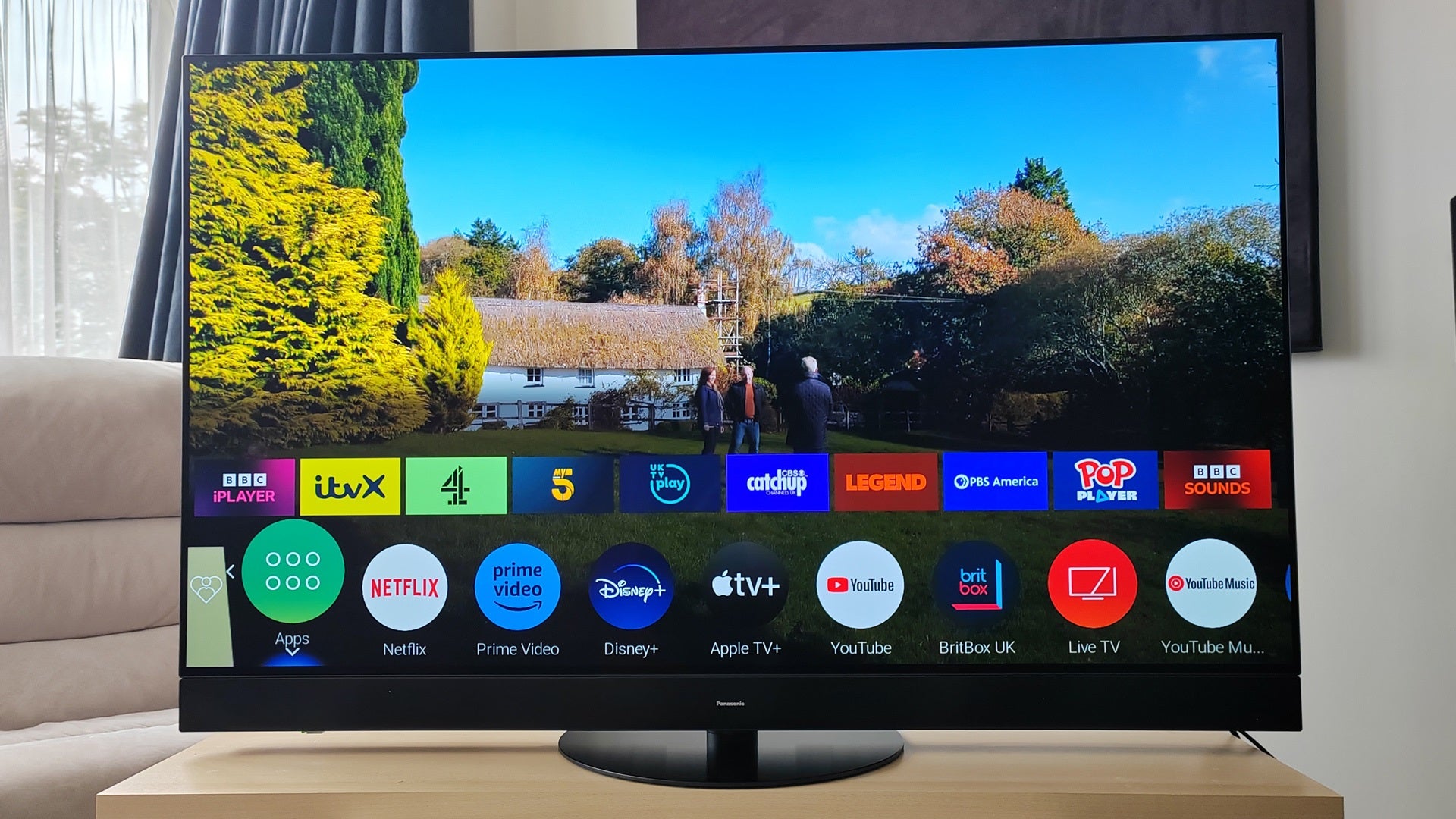Verdict
Panasonic has given its flagship OLED flatscreen a picture quality upgrade, with a high brightness MLA (Micro Lens Array) OLED panel. Coupled with a Hollywood tuned AI picture processor, and a best-in-class Dolby Atmos sound system, the MZ2000 has to be an odds on favourite to be telly of the year.
Pros
- Excellent HDR performance
- Dolby Vision IQ HDR support
- 360° Soundscape Pro Dolby Atmos system
- Game Board UI
Cons
- Only two HDMIs support 4K 120Hz
- Price
Availability
- UKRRP: £2699
- USAunavailable
- EuropeTBC
- Canadaunavailable
- Australiaunavailable
-
HDR supportCovers the major HDR formats in HDR10+ Adaptive, HDR10, HLG Photo, HLG, and Dolby Vision IQ -
SoundFeatures an upfiring Dolby Atmos audio system -
My Home Screen 8.0Latest version of Panasonic’s smart interface
Introduction
The MZ200 is the jewel in the crown of Panasonic’s 2023 OLED TV range. It utilises the latest MLA (Micro Lens Array) OLED panel technology, is driven by the brand’s revered HCX Pro AI processor and comes with more trimmings than a Christmas turkey.
Tasty extras include the latest version of Panasonic’s own My Home smart TV platform, an elaborate 360°Soundscape Pro Dolby Atmos audio system, an updated Game Control Board, and a host of processing refinements that promise to further elevate this screen’s AV performance. Is it unbeatable? Quite possibly…
The MZ2000 is available in three screen sizes, 55-, 65-, and 77-inch sizes (TX-55MZ2000, TX-65MZ2000 and TX-77MZ2000), priced at £2699, £3599 and £4499 respectively. I’m testing the 55-incher.
Design
- Swivel pedestal stand
- 4 x HDMI inputs
- Dolby Atmos audio system
Design wise the MZ200 holds no surprises. The screen uses exactly the same chassis as its predecessor, the LZ2000, and is distinguished mainly by a deftly integrated Dolby Atmos sound system, which combines a forward firing array, with left and right ‘surround’ drivers and an up-firing Dolby Atmos channel, all tuned by stablemate Hi-Fi brand Technics.
The colour scheme is black, with a wafer-thin screen wrap and a central pedestal stand that offers a generous amount of swivel. I like its style, but admit the set looks a little more substantial than some of its rivals at 69mm deep.
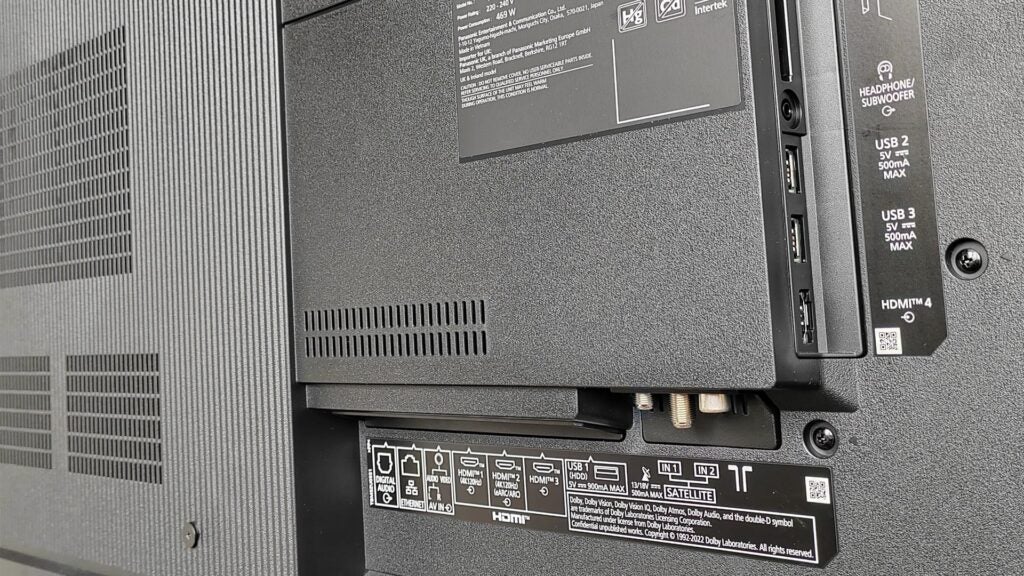
Connectivity comprises four HDMI inputs, of which two are 4K/120Hz enabled. HDMI 2 is also your eARC connection, which rather limits high frame rate options (a standard ARC connection on HDMI 3 or 4 would have been appreciated).
There’s also an optical digital audio output and AV mini Jack input. A Common Interface slot is provided for those who need it, along with three USB ports. Ethernet is on hand to support on-board Wi-Fi.
The set sports both terrestrial (with Freeview Play) and twin satellite input tuners.
The supplied Bluetooth remote is a premium design. It features dedicated buttons for Netflix, Rakuten TV, Prime Video, Disney+, YouTube and Freeview Play.
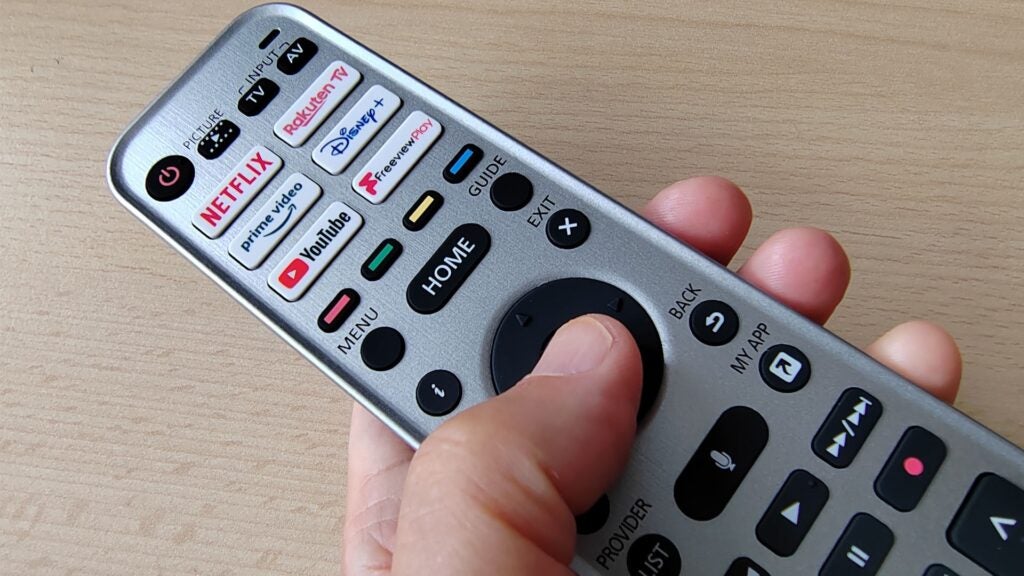
Features
- Master OLED Ultimate OLED panel
- My Home Screen v.8 Smart TV platform
- Updated Game modes
While the MZ2000 looks no different to last year’s model, the LZ2000 (winner of the Trusted Reviews coveted Best TV accolade in our 2022 Awards), there have been significant changes beneath the hood.
Of principal interest is the MLA panel, which better focuses light outwards (where you can see it), making images significantly brighter without having to increase power consumption.
The screen also comes with an advanced heat management system, which takes advantage of Panasonic’s various picture and audio processing improvements.
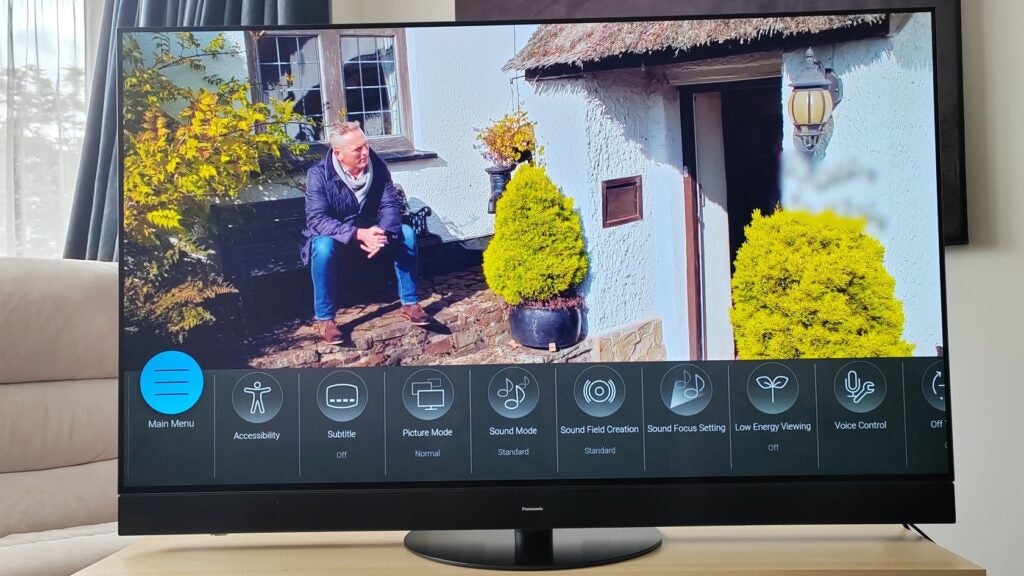
This new custom module is dubbed Master OLED Ultimate. It’s not just HDR intensity which benefits, but also average brightness, as evidenced by its punchy performance with daytime TV in brightly lit rooms.
Niceties include a new Streaming 4K Remaster algorithm able to identify the resolution of any source material and improve texture rendering. At no point during my audition did I spot intrusive banding or other noise driven artefacts (even when spinning a very grainy 4k Blu-ray remaster of The Evil Dead).
Panasonic has also upgraded Filmmaker mode, adding ambient colour temperature sensing to better match different room lighting.
Usability is excellent. The My Home Screen smart interface, now in its eighth iteration, remains easily customisable; you can choose to pin any particular service provider or terrestrial channel up front for quick access.
The main home screen overlay offers a contextual thumbnail rail for all the key Freeview Play channels, including BBC iPlayer, ITVX, Channel 4, My five, CBS catch up, and so on.
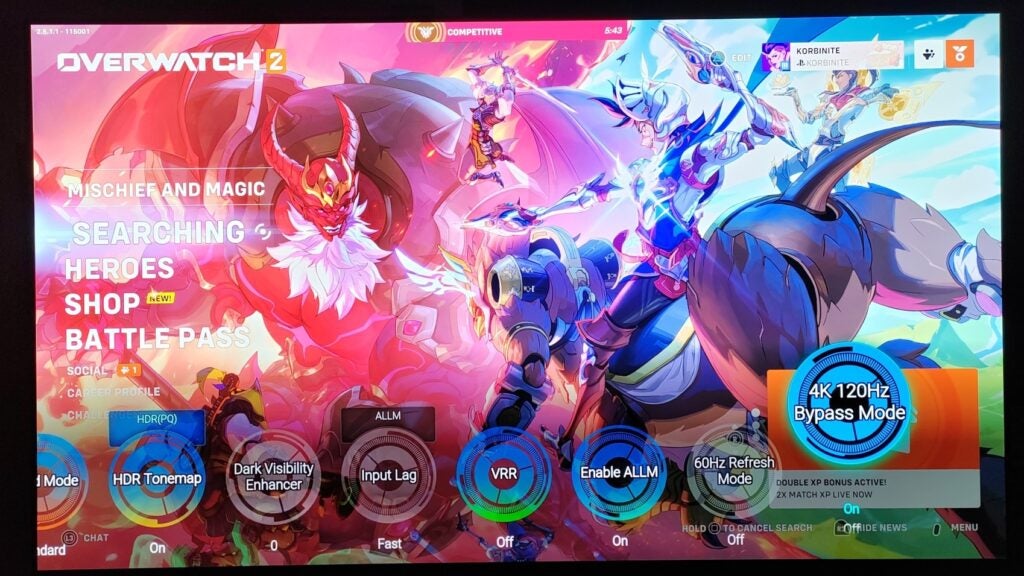
The Game Control Board is home to relevant info, such as resolution, frame rate, input lag, VRR and HDR, and has had improvements to its genre presets for FPS and RTS gaming. There are two Game modes to choose from: Game and True Game, as well as a 4k 120Hz bypass mode, although this desaturates colours a tad.
I measured input lag at an average 14.5ms (1080/60). Input lag improves when playing at 120Hz, but gameplay doesn’t feel quite as fluid as LG OLEDs I’ve gamed on.
Picture Quality
- Hugely bright HDR performance
- Rich and deep colours
That new MLA panel pays rich dividends. The MZ2000’s pictures are stunningly beautiful to look at, almost regardless of source. Blue and red primaries are deep and rich, and skin tones believably textured. It looks as pretty playing Overwatch in 4K as it does depicting the gritty HD drama of Lioness (Paramount+).
The MZ2000’s MLA-powered HDR performance is phenomenal. I measured peak HDR at 1698 nits, using a 10 per cent patch, in Dynamic mode, and whopping 1877 nits with a 5 per cent window. Using the Standard image preset, with a 5 per cent window, I recorded a comfortable 1500 nits.
Whatever way you cut it; this is significantly higher than what I saw on last year’s LZ2000. In practical terms, this means the set can comfortably display the majority of commercially available HDR content without recourse to tone mapping.
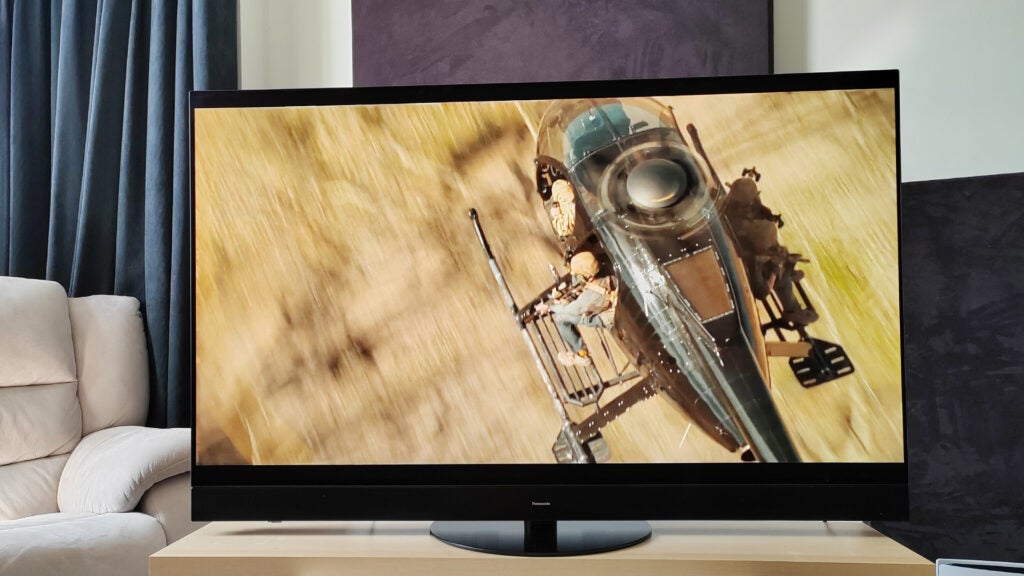
Streetlights burn bright, sunlight reflects with a genuine sparkle, explosions have terrific intensity; all this contributes to image depth and punch. A run through of Fast Five (UHD Blu-ray), which has plenty of sequences set in dimly lit garages, confirmed effortless near black shadow detail, and the glinting cars emphasise its HDR precision.
Unlike key rivals from LG and Samsung, there’s universal HDR support onboard. Dolby Vision IQ, HDR10+ Adaptive, HDR10, HLG, and HDR Photo.
Both the Dolby Vision IQ and HDR10+ Adaptive settings work with a light sensor to manage image parameters dynamically, making the set a great choice for anytime viewing. There’s also an Adaptive Netflix Calibrated mode.
Sound Quality
- Dolby Atmos audio
- Not the biggest bass performance
Overall sonic performance is top notch. The provision of side and up-firing speakers ensures the 150W soundstage is deliciously huge, and clarity is consistently impeccable. But the system is still light on bass.
When Dom Toretto is liberated from his prison bus at the start of Fast Five, the sound system does a fine job depicting the roar of Toretto’s muscle car rescuers, but when his prison bus rolls there’s a distinct lack of weight.
That said, the MZ2000 offers more audio options than most TVs in its class. Not just when it comes to channel configuration and deployment, but also additional processing.
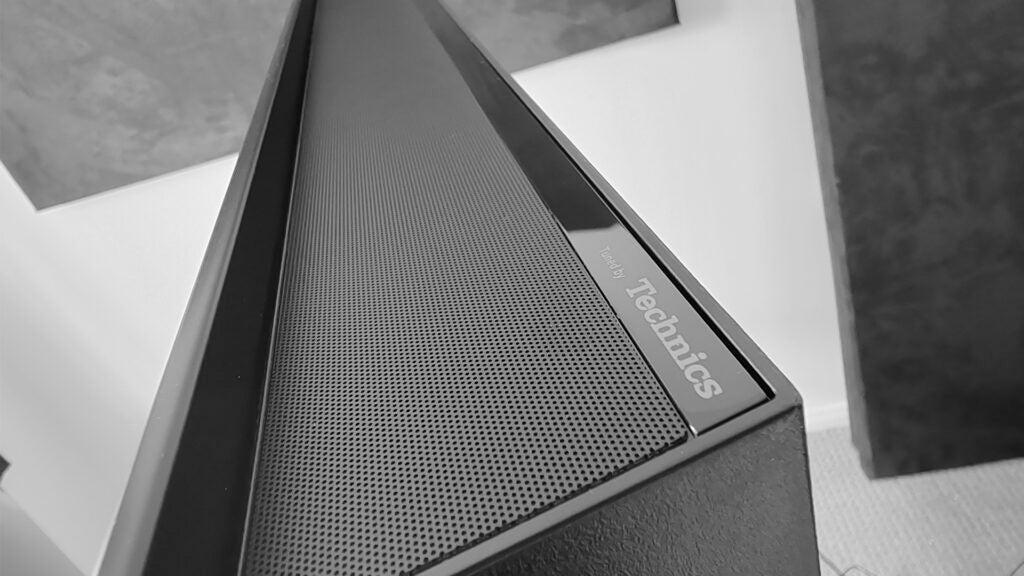
First introduced on the LZ2000, beam steering allows you to tailor the direction of sound from the front bar (in this mode its output is quite monophonic), allowing you to focus audio specifically into a room, steered using an onscreen graphic.
In addition to Dolby Atmos decoding, there’s also a Sound Field Creation menu which applies various degrees of DSP post processing. Choose from Direct, Sport, Live theatre, Standard, or Talk. These are mainly a matter of personal taste. For most TV and movie content, Direct is always the better choice.
Latest deals
Should you buy it?
If you want the best combination of OLED panel performance and processing: This TV comfortably delivers more than 1500 nits with universal HDR compliance and arguably the best cinematic image processor in town, the MZ2000 doesn’t disappoint when it comes to picture quality.
The MZ2000’s 360° Soundscape Pro audio system could do with more bass: For all its multiplicity of speakers, the MZ2000 is light on bass, so if you want really cinematic slam, it might be best to plan for a separate sound system.
Final Thoughts
The MZ200 takes full advantage of its next gen MLA OLED panel, and image quality is sensational. The set’s universal HDR provision, and superb contrast management, compounds the proposition. This screen is a top choice for movie fans.
It gets a less clear cut recommendation when it comes to gaming. While Panasonic has updated gaming functionality, the set is still hampered by an HDMI board which offers just two 4K/120Hz capable inputs. Given one of those is also your eARC connection, owners of both an Xbox Series X/S and PlayStation 5 will probably look elsewhere.
For the rest of us, provided you can dig deep enough, it’s a premium grade slam dunk.
How we test
We test every television we review thoroughly over an extended period of time. We use industry standard tests to compare features properly. We’ll always tell you what we find. We never, ever, accept money to review a product.
Find out more about how we test in our ethics policy.
Tested with real world use
Tested across several weeks
FAQs
The current information we have is that the MZ2000 does support Dolby Vision Gaming, but only up to 4K/60Hz refresh rates.
Jargon buster
Dolby Vision IQ
Dolby Vision IQ is an advanced version of the standard Dolby Vision signal. It uses the metadata within its own HDR signal in conjunction with a TV’s light sensor to detect how bright or how dark a room is in order to optimise the picture quality so content retains consistent luminance (brightness) and detail no matter how bright or dark the room is.
Dolby Atmos
Dolby Atmos is an object-based audio format. It expands on 5.1 and 7.1 soundtracks by adding overhead channels. Sounds are referred to as “audio objects”, of which there can be up to 128 audio channels, and these ‘objects’ can be accurately positioned within a 3D soundscape. This allows soundtracks that support the technology to place sounds above and around the listener with compatible kit.
Verdict
Panasonic has given its flagship OLED flatscreen a picture quality upgrade, with a high brightness MLA (Micro Lens Array) OLED panel. Coupled with a Hollywood tuned AI picture processor, and a best-in-class Dolby Atmos sound system, the MZ2000 has to be an odds on favourite to be telly of the year.
Pros
- Excellent HDR performance
- Dolby Vision IQ HDR support
- 360° Soundscape Pro Dolby Atmos system
- Game Board UI
Cons
- Only two HDMIs support 4K 120Hz
- Price
Availability
- UKRRP: £2699
- USAunavailable
- EuropeTBC
- Canadaunavailable
- Australiaunavailable
-
HDR supportCovers the major HDR formats in HDR10+ Adaptive, HDR10, HLG Photo, HLG, and Dolby Vision IQ -
SoundFeatures an upfiring Dolby Atmos audio system -
My Home Screen 8.0Latest version of Panasonic’s smart interface
Introduction
The MZ200 is the jewel in the crown of Panasonic’s 2023 OLED TV range. It utilises the latest MLA (Micro Lens Array) OLED panel technology, is driven by the brand’s revered HCX Pro AI processor and comes with more trimmings than a Christmas turkey.
Tasty extras include the latest version of Panasonic’s own My Home smart TV platform, an elaborate 360°Soundscape Pro Dolby Atmos audio system, an updated Game Control Board, and a host of processing refinements that promise to further elevate this screen’s AV performance. Is it unbeatable? Quite possibly…
The MZ2000 is available in three screen sizes, 55-, 65-, and 77-inch sizes (TX-55MZ2000, TX-65MZ2000 and TX-77MZ2000), priced at £2699, £3599 and £4499 respectively. I’m testing the 55-incher.
Design
- Swivel pedestal stand
- 4 x HDMI inputs
- Dolby Atmos audio system
Design wise the MZ200 holds no surprises. The screen uses exactly the same chassis as its predecessor, the LZ2000, and is distinguished mainly by a deftly integrated Dolby Atmos sound system, which combines a forward firing array, with left and right ‘surround’ drivers and an up-firing Dolby Atmos channel, all tuned by stablemate Hi-Fi brand Technics.
The colour scheme is black, with a wafer-thin screen wrap and a central pedestal stand that offers a generous amount of swivel. I like its style, but admit the set looks a little more substantial than some of its rivals at 69mm deep.

Connectivity comprises four HDMI inputs, of which two are 4K/120Hz enabled. HDMI 2 is also your eARC connection, which rather limits high frame rate options (a standard ARC connection on HDMI 3 or 4 would have been appreciated).
There’s also an optical digital audio output and AV mini Jack input. A Common Interface slot is provided for those who need it, along with three USB ports. Ethernet is on hand to support on-board Wi-Fi.
The set sports both terrestrial (with Freeview Play) and twin satellite input tuners.
The supplied Bluetooth remote is a premium design. It features dedicated buttons for Netflix, Rakuten TV, Prime Video, Disney+, YouTube and Freeview Play.

Features
- Master OLED Ultimate OLED panel
- My Home Screen v.8 Smart TV platform
- Updated Game modes
While the MZ2000 looks no different to last year’s model, the LZ2000 (winner of the Trusted Reviews coveted Best TV accolade in our 2022 Awards), there have been significant changes beneath the hood.
Of principal interest is the MLA panel, which better focuses light outwards (where you can see it), making images significantly brighter without having to increase power consumption.
The screen also comes with an advanced heat management system, which takes advantage of Panasonic’s various picture and audio processing improvements.

This new custom module is dubbed Master OLED Ultimate. It’s not just HDR intensity which benefits, but also average brightness, as evidenced by its punchy performance with daytime TV in brightly lit rooms.
Niceties include a new Streaming 4K Remaster algorithm able to identify the resolution of any source material and improve texture rendering. At no point during my audition did I spot intrusive banding or other noise driven artefacts (even when spinning a very grainy 4k Blu-ray remaster of The Evil Dead).
Panasonic has also upgraded Filmmaker mode, adding ambient colour temperature sensing to better match different room lighting.
Usability is excellent. The My Home Screen smart interface, now in its eighth iteration, remains easily customisable; you can choose to pin any particular service provider or terrestrial channel up front for quick access.
The main home screen overlay offers a contextual thumbnail rail for all the key Freeview Play channels, including BBC iPlayer, ITVX, Channel 4, My five, CBS catch up, and so on.

The Game Control Board is home to relevant info, such as resolution, frame rate, input lag, VRR and HDR, and has had improvements to its genre presets for FPS and RTS gaming. There are two Game modes to choose from: Game and True Game, as well as a 4k 120Hz bypass mode, although this desaturates colours a tad.
I measured input lag at an average 14.5ms (1080/60). Input lag improves when playing at 120Hz, but gameplay doesn’t feel quite as fluid as LG OLEDs I’ve gamed on.
Picture Quality
- Hugely bright HDR performance
- Rich and deep colours
That new MLA panel pays rich dividends. The MZ2000’s pictures are stunningly beautiful to look at, almost regardless of source. Blue and red primaries are deep and rich, and skin tones believably textured. It looks as pretty playing Overwatch in 4K as it does depicting the gritty HD drama of Lioness (Paramount+).
The MZ2000’s MLA-powered HDR performance is phenomenal. I measured peak HDR at 1698 nits, using a 10 per cent patch, in Dynamic mode, and whopping 1877 nits with a 5 per cent window. Using the Standard image preset, with a 5 per cent window, I recorded a comfortable 1500 nits.
Whatever way you cut it; this is significantly higher than what I saw on last year’s LZ2000. In practical terms, this means the set can comfortably display the majority of commercially available HDR content without recourse to tone mapping.

Streetlights burn bright, sunlight reflects with a genuine sparkle, explosions have terrific intensity; all this contributes to image depth and punch. A run through of Fast Five (UHD Blu-ray), which has plenty of sequences set in dimly lit garages, confirmed effortless near black shadow detail, and the glinting cars emphasise its HDR precision.
Unlike key rivals from LG and Samsung, there’s universal HDR support onboard. Dolby Vision IQ, HDR10+ Adaptive, HDR10, HLG, and HDR Photo.
Both the Dolby Vision IQ and HDR10+ Adaptive settings work with a light sensor to manage image parameters dynamically, making the set a great choice for anytime viewing. There’s also an Adaptive Netflix Calibrated mode.
Sound Quality
- Dolby Atmos audio
- Not the biggest bass performance
Overall sonic performance is top notch. The provision of side and up-firing speakers ensures the 150W soundstage is deliciously huge, and clarity is consistently impeccable. But the system is still light on bass.
When Dom Toretto is liberated from his prison bus at the start of Fast Five, the sound system does a fine job depicting the roar of Toretto’s muscle car rescuers, but when his prison bus rolls there’s a distinct lack of weight.
That said, the MZ2000 offers more audio options than most TVs in its class. Not just when it comes to channel configuration and deployment, but also additional processing.

First introduced on the LZ2000, beam steering allows you to tailor the direction of sound from the front bar (in this mode its output is quite monophonic), allowing you to focus audio specifically into a room, steered using an onscreen graphic.
In addition to Dolby Atmos decoding, there’s also a Sound Field Creation menu which applies various degrees of DSP post processing. Choose from Direct, Sport, Live theatre, Standard, or Talk. These are mainly a matter of personal taste. For most TV and movie content, Direct is always the better choice.
Latest deals
Should you buy it?
If you want the best combination of OLED panel performance and processing: This TV comfortably delivers more than 1500 nits with universal HDR compliance and arguably the best cinematic image processor in town, the MZ2000 doesn’t disappoint when it comes to picture quality.
The MZ2000’s 360° Soundscape Pro audio system could do with more bass: For all its multiplicity of speakers, the MZ2000 is light on bass, so if you want really cinematic slam, it might be best to plan for a separate sound system.
Final Thoughts
The MZ200 takes full advantage of its next gen MLA OLED panel, and image quality is sensational. The set’s universal HDR provision, and superb contrast management, compounds the proposition. This screen is a top choice for movie fans.
It gets a less clear cut recommendation when it comes to gaming. While Panasonic has updated gaming functionality, the set is still hampered by an HDMI board which offers just two 4K/120Hz capable inputs. Given one of those is also your eARC connection, owners of both an Xbox Series X/S and PlayStation 5 will probably look elsewhere.
For the rest of us, provided you can dig deep enough, it’s a premium grade slam dunk.
How we test
We test every television we review thoroughly over an extended period of time. We use industry standard tests to compare features properly. We’ll always tell you what we find. We never, ever, accept money to review a product.
Find out more about how we test in our ethics policy.
Tested with real world use
Tested across several weeks
FAQs
The current information we have is that the MZ2000 does support Dolby Vision Gaming, but only up to 4K/60Hz refresh rates.
Jargon buster
Dolby Vision IQ
Dolby Vision IQ is an advanced version of the standard Dolby Vision signal. It uses the metadata within its own HDR signal in conjunction with a TV’s light sensor to detect how bright or how dark a room is in order to optimise the picture quality so content retains consistent luminance (brightness) and detail no matter how bright or dark the room is.
Dolby Atmos
Dolby Atmos is an object-based audio format. It expands on 5.1 and 7.1 soundtracks by adding overhead channels. Sounds are referred to as “audio objects”, of which there can be up to 128 audio channels, and these ‘objects’ can be accurately positioned within a 3D soundscape. This allows soundtracks that support the technology to place sounds above and around the listener with compatible kit.


















